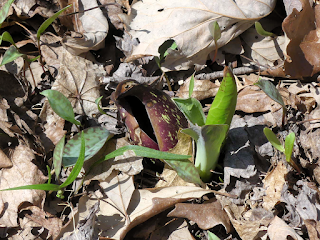Skunk Cabbage
Here's some Skunk Cabbage I saw earlier this month. This is an interesting plant.
- Since I have almost no sense of smell, I can't personally appreciate the smell though that's probably what it's best know for. Apparently the flower (see the non-green part in the picture below) emits the smell to attract pollinators; while you might not like the smell, pollinators know there's a feast waiting for them.
- If the leaves are damaged, they can also emit this odor. This might deter some animals that would like to eat their leaves, or just stomp on them to get to other food.
- They're a bit of a misnomer; they're neither skunks (obviously) nor cabbages (less obvious). They're in the araceae family.
- They are thermogenic plants; they're able to raise their temperature higher than the surrounding environment. While most plants have to wait for the ground to thaw before appearing, the Skunk Cabbage can get the jump on most other plants by generating its own heat.
- Being an early-blooming plant, they're especially important to jumpstart the spring ecosystem by providing food for pollinators. Some of these pollinators then end up as food further up the food chain.
 |
| April 5, 2021 at Raritan River Greenway Photo 120290237, (c) jpviolette, some rights reserved (CC BY-NC) |



Comments
Post a Comment